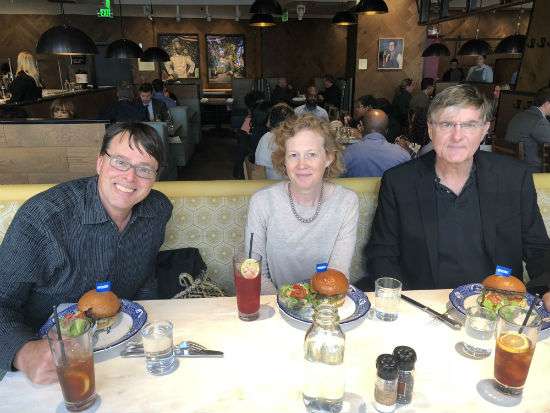Finally Fake Meat that Tastes Deliciously Like the Real Thing
Tasty Impossible Burger uses 95 percent less land, uses 74 percent less water, and emits 87 percent less greenhouse gas.

I am an omnivore with strong carnivore tendencies. I grew up on a farm where my family slaughtered and butchered our own cows, pigs, chickens, goats, turkeys, lambs, and geese. We also ate an occasional squirrel, groundhog, opposum, and mud turtle. My father's rule with regard to butchering beef was cut everything that you can into steaks and make the rest into hamburger.
As a result of my upbringing, I am picky about the beef I eat. So I was a bit skeptical when two out-of-town science reporter acquaintances suggested we get together and eat some Impossible Burgers. I am now won over—Impossible Burgers will delight most carnivores.
Emma Marris (author of the superb Rambunctious Garden: Saving Nature in a Post-Wild World) and Charles C. Mann (author of the excellent 1491: New Revelations of the Americas Before Columbus) and I trooped over yesterday to the Founders and Distillers restaurant, one of four dining establishments offering Impossible Burgers in Washington, D.C.
All three of us opted for the F&D All American—a double patty burger garnished with cheddar cheese, pickled relish, "comeback" sauce, lettuce, tomato, and onion. The Impossible Burger costs a dollar more than the beef version does.
The burgers arrived and upon close inspection there were no evident differences in the appearance of the patties from a regular beef burger. Of course, the real test was in the taste. We bit in and looked at each other with some surprise. The burgers tasted really good. They have the texture and mouth feel of a regular burger. There were even some delightful, off-the-grill crunchy charred bits scattered through the patties. Emma quipped that they tasted like the kind of burgers you'd get at a high school fundraising barbecue.

Unless you concentrated really hard, you'd never know that the burgers are made entirely of ingredients derived from plants.
Impossible Foods, a Silicon Valley start-up, manufactures the burgers chiefly from textured wheat protein, potato protein, coconut oil, and leghemoglobin, the key ingredient. Leghemoglobin is an iron-containing molecule that occurs naturally in every single plant and animal. It is the abundance of this heme in animal muscles that gives meat much of its distinctive deliciousness. The heme in Impossible Burgers is derived from soybeans and produced by fermenting yeast genetically enhanced to make it.
Other than trying to placate vegetarians and vegans, why bother creating Impossible Burgers? Founder Patrick O. Brown says that the company is on a mission to make the global food system more sustainable. The company claims that compared to cows, the Impossible Burger uses 95 percent less land, 74 percent less water, and creates 87 percent less greenhouse gas emissions.
Assuming that Impossible Burgers and other future plant-based meat competitors catch on with consumers, they will be another happy example of how human ingenuity is continuing our withdrawal from nature. These may be good reasons for people to eat Impossible Burgers, but I will happily do it because I enjoy the taste.


Show Comments (126)